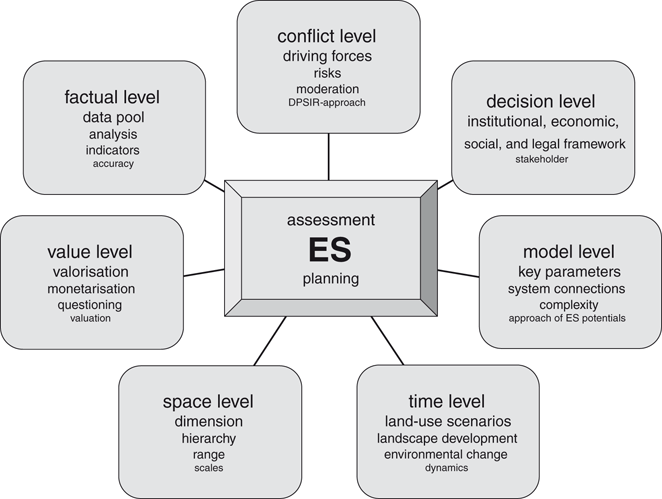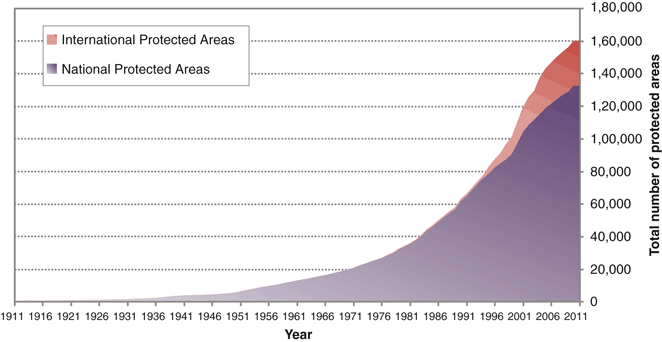Ecosystem Services (ES): More Than Just a Vogue Term?

Fig. 1.1
Nature conservation and economy–a new alliance?
“The economic evaluation of ecosystem services, including existence, option and bequest values, conceptually permits the complete ascertainment of the effects of land-use and biotope changes upon societal welfare.”
Ecosystem Services (ES)
describes the services rendered by nature and use by humankind. According to the Millennium Ecosystem Assessment (MEA 2005) , these are supporting services (such as soil formation, photosynthesis), and following provisioning services (such as food), regulation services (such as erosion control) and cultural services (such as landscape aesthetics as basis of recreation and tourism). We recommend a trinomial classification , with provisioning, regulation and sociocultural services ; ▶ Chap. 3.2) , since these correspond with sustainability categories. Effects vitally necessary for human well-being are based on these services, including provision with food, protection from natural hazards, with the supply of clean water. Societal value creation is to be weighted by means of the ES concept, and evaluated in part–but not entirely–monetarily (cost-benefit calculations), so as to promote commitment to the preservation of nature for economic reasons as well (Jessel et al. 2009).
At the latest since the study by Costanza et al. (1997), in which worldwide ES were calculated, their significance for humankind is no longer deniable. The extent of the dependence of humankind on ES has been shown dramatically by the example of pollination by wild bees, upon which 15 to 30 % of US food production , with a total value of $ 30 billion, depends (Kremen 2005; EASAC 2009).
Nonetheless, ascertaining the scope of ES and the societal negotiation of its value priority, including an economic assessment of its value, still faces numerous challenges. Numerous ES, such as the beneficial effects of biological diversity , have been little investigated to date (Mosbrugger and Hofer 2008). In particular, there has been a lack of quantitative systemic understanding, i. e. of comprehensive knowledge of the process interconnections.
ES is such a current, exciting, complex, integrative, and open-end issue that numerous scientists and practitioners worldwide have been involved with it. ◉ Figure 1.2 shows that the number of scientific papers on ES in recent years has risen exponentially. There have been numerous attempts to index, quantify and map ES. However, recent meta-analyses in that area (e.g., Elsasser and Meyerhoff 2007; Goldman et al. 2008; Feld et al. 2009; Jacobsen and Hanley 2009; Seppelt et al. 2011; Brouwer et al. 2013), have shown, that there is as yet no comprehensive, generally accepted methodological system.

Fig. 1.2
Growth in number of papers on ecosystem services since 1990. The graph is based on searching ISI web of science using the terms ecologicalor ecosystem service(s). Most ES-related papers were published in the journal Ecological Economics. (Source: Peterson 2010)
1.1 The ES Concept has Received Considerable Recognition from the Scientific Community and from Political Decision-Makers
However, what that means locally is usually not very clear; in any case, such labels as ‘the economization of conservation’, or ‘improvement of the quality of life’ are misleading and short-sighted. In this context, we will repeatedly be dealing with complex, ambiguous terms such as ecosystem, service, capital, landscape, environment, function, space , time or value, from a number of perspectives. The following quote from the Senate Commission on Future Directions in Geoscience of the German Research Foundation (DFG; cf. DFG 2011) shows some of the stumbling blocks:
’One important challenge is to quantitatively ascertain the biogeochemical turnover processes which drive global material cycles. These processes are called ‘ecosystem functions’ and ‘ecosystem services’. They are of great significance for humankind and for climate change.”
1.1.1 Calls for Valuation of ES
‘We need strong awareness of the value of ecosystems and their services. Moral appeals and alarmism are of little help to nature. What can help counter species loss is effective management of well networked protected areas, and new land-use models with synergy effects. Primarily however, the economic value of ‘green infrastructure’ must at long last be accorded recognition.’ (Beate Jessel, President of the German Federal Agency for the Conservation of Nature, in: umwelt aktuell, April 2010).
‘The loss of natural capital (including ecosystems, biodiversity and natural resources) has direct and widespread negative effects on financial performance . Climate change and the financial crisis suggest that significant systemic risk requires coordinated policy intervention. The financial markets do not yet understand that many companies face specific risks from disruptions of vital ecosystems through their supply chains, and that they need to plan for the impact of new regulation.’ (Colin Melvin, Hermes Equity Ownership Services Ltd., in: Demystifying Materiality: Hardwiring Biodiversity and Ecosystem Services into Finance,UNEP-CEObriefing, October 2010).
‘Maybe the ecology movement shouldn’t always just appealed to people’s consciences, but rather view the issue from the point of view of the market economy’ (Ebert 2011).
How Endangered are our Ecosystems? Why are ES and Biodiversity Often Mentioned in the Same Breath?
The approximately 1300 participants in the international study MEA (2001–2005) reached the conclusion that a sufficient supply of ES for future generations cannot be assured, because ecosystems are being changed, damaged and transformed. In a survey by the Austrian Forum for Science and the Environment, experts gave a largely negative assessment of the development of our habitats (‘Die Presse’, print version, 1.4.2010). Human use of nature is causing a death of species at 100 to 1000 times the natural rate (Rockström et al. 2009).
In the EU and Germany, biodiversity goals, i. e. the goal of stopping the decline of biodiversity, have not been achieved to date, which has had a negative effect on such services provided by ecosystems as pollination services. Investigations have shown that without new policy approaches, the loss of biodiversity will continue (PBL 2010). Everybody realises that ‘in a prosperous world with approximately 7 billion people (2011), a powerful advance of innovation must be initiated in order to secure ES and to make a resource-saving development possible’ (WBGU 2011).
The term Ecosystem
goes back to the British biologist and plant ecologists Arthur George Tansley, who introduced it as a fundamental principle in the ecology (Tansley 1935). An ecosystem contains the structure of interrelationships of living beings to one another, and to their inorganic environment. In the less abstract sense, an ecosystem is characterised by its long-term relationship (biocenosis) and its habitat (biotope) (Ellenberg et al. 1992). Since Tansley, an international interdisciplinary and transdisciplinary ecosystem research community has emerged, and has attempted to develop and apply holistic and systemic concepts. Ecosystem research is a conceptual approach with which particularly natural scientists identify, since analytic models of the structure and dynamics of spatial segments can be processed.
Biodiversity or Biological Diversity,
according to the Convention on Biological Diversity (CBD), means ‘the variability among living organisms from all sources including, inter alia, terrestrial, marine and other aquatic ecosystems and the ecological complexes of which they are part; this includes diversity within species, between species and of ecosystems’ (CBD 2010). According to this definition, which is binding under international law, biodiversity consists of the diversity of species, the diversity of ecosystems, and genetic diversity .
Since the diversity of ecosystems, biotic associations and landscapes are part of biodiversity, ES and biodiversity are often mentioned in the same breath (e.g. Ridder 2008; TEEB 2009). Biodiversity particularly supports the ‘functioning of ecosystems’ ; however, it can also be defined as an ES in its own right–the ecosystem service of providing biodiversity. While both concepts overlap, they are in no sense identical. Undoubtedly, the continued loss of biodiversity will also have an impact on ES; however, generally, no simple, linear relationship can be assumed (Giller and O’Donnovan 2002; IEEP 2009; Trepl 2012). For many ES evaluated, maximum possible biodiversity is not necessary; rather, sometimes a lower number of species is favourable or sufficient, and sometimes a higher number.
Jessel (2011) describes the differences between the terms biodiversity and ES as follows:
ES is broader than biodiversity (e.g. sociocultural ES)
The perspectives are fundamentally different: ES focuses on properties of ecosystems for the purpose of maintaining their services, whereas biodiversity focuses on the number and characteristics of the biotic components of nature
The ES approach is more strongly anthropocentrically oriented
The protection of biodiversity implicitly presupposes the preservation of variety in all its components, and is hence fundamentally statically oriented; for ES, by contrast, not all components of the ecosystem are in all cases necessary in order to maintain services.
“A planning guide for the loss of biological diversity is difficult to define, due to the large number of species, the extreme difference of their significance for the functioning of the ecosystem, and our huge knowledge gaps” (WBGU 2011). The worldwide network of protected areas, which has been considerably expanded in recent decades (◉ Fig. 1.3), and which is to be expanded further from the current 12 % of the world’s land area (+ 10 % of the maritime area) to 17 % by 2020 (CBD 2010), will certainly have a positive effect on ES and biodiversity, but has not been able to halt, much less reverse, the rate of loss with respect to most biodiversity parameters, especially species development and habitat conditions (◉ Fig. 1.4). For this reason, the focus will in future be increasingly upon issues of ‘sustainable land use’ on more or less intensively managed areas of land .
